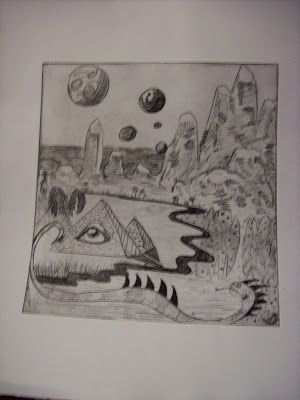
Welcome back to my blog for yet another session of TMI. Today I join you with a propaganda poster I made for one of my classes. This poster features my best-known cartoon character, Dumpy Dolores. Let's see what elements are contributing to this piece, shall we?
A little background: last year in 2009 I was found out by the police after running a graffiti campaign of hand made sticker art. Although there were several characters that popped in and out of the rotation, Dumpy Dolores was by far the bread and butter of the campaign. So, a workweek's worth of court dates and $2,200+ later, Dumpy Dolores has fallen by the way side, especially in sticker form where she is most beloved by her fans.
So, for this assignment we had to make a propaganda poster. This is a cinch for me personally because I am a fan of poster art and fascinated by the concept of subversive text. The inspiration came from my own experiences with the law and my astonishment for being punished so harshly for something that really isn't malicious. In the spirit of political prisoners and favored celebrities under harsh treatment by foreign governments or their own governments, I created this poster.
Symbolically we were supposed to employ subject matter and use colors that contributed to the overall experience of the piece. For this I chose to use red to suggest anger and outrage, blue to suggest purity and truth, black to suggest desolation and gray to hint at sadness and sympathy. The subject matter shows Dumpy Dolores behind prison bars (which I am lucky to have not been put behind) within a brickwall with keyholes, suggesting some sort of imprisonment. The text on the arch says "VIGILANCE UBIQUITOUS" which is supposed to be a haunting slogan that reminds people to watch over her. I happen to love those words a lot.
The poster is on bristol board with magic marker, paint marker and water color.
One thing I always think about are the 42 stickers the Montclair police confiscated... presumably they are rotting away in some evidence locker or perhaps they were destroyed... Either way, Dumpy Dolores is making an agonizing crawl back to the sticker scene... eventually.
Thanks for reading!



